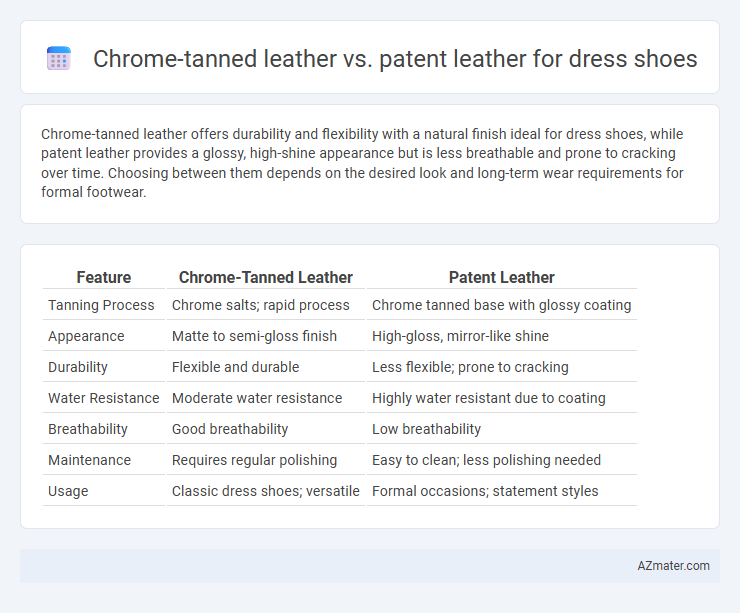Chrome-tanned leather offers durability and flexibility with a natural finish ideal for dress shoes, while patent leather provides a glossy, high-shine appearance but is less breathable and prone to cracking over time. Choosing between them depends on the desired look and long-term wear requirements for formal footwear.
Table of Comparison
| Feature | Chrome-Tanned Leather | Patent Leather |
|---|---|---|
| Tanning Process | Chrome salts; rapid process | Chrome tanned base with glossy coating |
| Appearance | Matte to semi-gloss finish | High-gloss, mirror-like shine |
| Durability | Flexible and durable | Less flexible; prone to cracking |
| Water Resistance | Moderate water resistance | Highly water resistant due to coating |
| Breathability | Good breathability | Low breathability |
| Maintenance | Requires regular polishing | Easy to clean; less polishing needed |
| Usage | Classic dress shoes; versatile | Formal occasions; statement styles |
Introduction to Chrome-Tanned Leather and Patent Leather
Chrome-tanned leather, processed using chromium salts, offers enhanced softness, flexibility, and water resistance, making it a popular choice for durable and comfortable dress shoes. Patent leather features a high-gloss finish created by applying a lacquer or plastic coating to the leather surface, resulting in a sleek, shiny appearance favored for formal occasions. Understanding the distinct tanning methods and finishes helps in selecting dress shoes that balance aesthetics, comfort, and durability.
Key Differences Between Chrome-Tanned and Patent Leather
Chrome-tanned leather features a soft, flexible texture due to the chromium salts used in the tanning process, making it highly durable and resistant to water and heat. Patent leather is coated with a glossy, lacquered finish that provides a shiny, mirror-like appearance but is less breathable and prone to cracking over time. For dress shoes, chrome-tanned leather offers comfort and longevity, while patent leather excels in formal events requiring a polished, sleek look.
Appearance: Matte vs High-Gloss Finish
Chrome-tanned leather offers a matte finish that provides a subtle, natural look, ideal for understated elegance in dress shoes. Patent leather, characterized by its high-gloss, mirror-like shine, creates a bold and polished appearance perfect for formal occasions. The choice between matte and high-gloss finish significantly influences the shoe's style and the impression it conveys.
Durability and Longevity Comparison
Chrome-tanned leather offers superior durability and resistance to water and heat, making it ideal for everyday dress shoes with extended wear. Patent leather, while highly polished and visually striking, tends to be less breathable and more prone to cracking over time, reducing its longevity. For dress shoes requiring long-lasting performance and durability, chrome-tanned leather is generally the more robust choice.
Comfort and Flexibility in Dress Shoes
Chrome-tanned leather offers superior comfort and flexibility in dress shoes due to its softer texture and enhanced breathability, which conforms well to the foot over time. Patent leather, being coated with a glossy finish, is stiffer and less breathable, often causing less comfort during extended wear. For all-day comfort and ease of movement, chrome-tanned leather is the preferred material in dress shoes.
Water and Stain Resistance
Chrome-tanned leather offers moderate water resistance due to its chemical tanning process, which stabilizes the hide and provides some level of protection against stains and moisture. Patent leather, coated with a glossy, plastic layer, excels in water and stain resistance by creating a nearly impermeable surface that repels liquids and dirt more effectively. For dress shoes exposed to wet or dirty environments, patent leather provides superior durability against water and stains compared to chrome-tanned leather.
Maintenance and Care Tips
Chrome-tanned leather requires regular conditioning with leather cream to prevent drying and cracking, while patent leather demands frequent gentle cleaning with a damp cloth to maintain its glossy finish. Avoid exposure of chrome-tanned leather to excessive water, and store it with shoe trees to retain shape; patent leather is more water-resistant but prone to scuff marks, so use a patent leather polish or petroleum jelly to restore shine. Both types benefit from proper storage in a cool, dry place away from direct sunlight to prolong their durability and appearance.
Environmental Impact of Tanning Processes
Chrome-tanned leather, processed using chromium salts, is energy-efficient but poses significant environmental risks due to toxic heavy metal waste that can contaminate water sources if not properly managed. Patent leather, which often uses a chrome-tanned base coated with a plastic or lacquer finish, inherits these environmental hazards while adding concerns related to synthetic coatings and their non-biodegradability. Sustainable alternatives and improved waste treatment methods are critical to reducing the ecological footprint associated with both chrome-tanned and patent leather dress shoes.
Price Point and Value for Money
Chrome-tanned leather dress shoes generally offer a lower price point while maintaining good durability and comfort, making them a cost-effective option for everyday wear. Patent leather shoes, with their glossy finish and higher production costs, tend to be more expensive but provide superior visual appeal and formal value. Evaluating purchase decisions should weigh chrome leather's affordability and practicality against patent leather's premium look and occasional use in special occasions.
Which Leather is Best for Dress Shoes?
Chrome-tanned leather offers durability, flexibility, and water resistance, making it ideal for dress shoes worn frequently or in varied conditions. Patent leather provides a high-gloss finish that enhances formal appearance but is less breathable and prone to cracking over time. For long-lasting, versatile dress shoes, chrome-tanned leather is generally considered the best choice.

Infographic: Chrome-tanned leather vs Patent leather for Dress shoe
 azmater.com
azmater.com